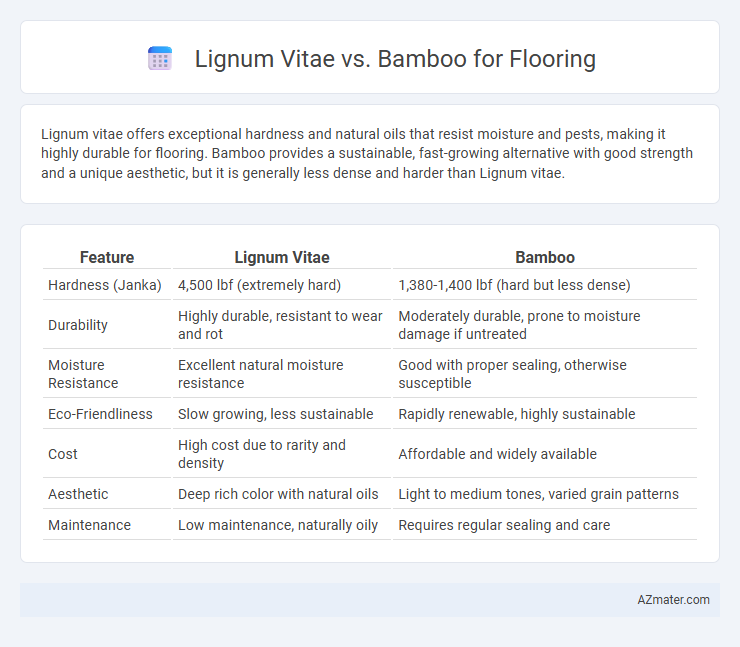Lignum vitae offers exceptional hardness and natural oils that resist moisture and pests, making it highly durable for flooring. Bamboo provides a sustainable, fast-growing alternative with good strength and a unique aesthetic, but it is generally less dense and harder than Lignum vitae.
Table of Comparison
| Feature | Lignum Vitae | Bamboo |
|---|---|---|
| Hardness (Janka) | 4,500 lbf (extremely hard) | 1,380-1,400 lbf (hard but less dense) |
| Durability | Highly durable, resistant to wear and rot | Moderately durable, prone to moisture damage if untreated |
| Moisture Resistance | Excellent natural moisture resistance | Good with proper sealing, otherwise susceptible |
| Eco-Friendliness | Slow growing, less sustainable | Rapidly renewable, highly sustainable |
| Cost | High cost due to rarity and density | Affordable and widely available |
| Aesthetic | Deep rich color with natural oils | Light to medium tones, varied grain patterns |
| Maintenance | Low maintenance, naturally oily | Requires regular sealing and care |
Introduction to Lignum Vitae and Bamboo Flooring
Lignum vitae, renowned for its exceptional density and natural oils, offers unparalleled durability and resistance to wear, making it a premium choice for flooring in high-traffic areas. Bamboo flooring, derived from fast-growing grass, provides an eco-friendly alternative that combines hardness with flexibility, available in various styles such as strand-woven and horizontal to suit different aesthetics. Both materials deliver unique benefits, with Lignum vitae excelling in longevity and natural luster, while bamboo emphasizes sustainability and cost-effectiveness.
Botanical Sources and Material Origins
Lignum vitae, derived from the Guaiacum genus native to the Caribbean and the northern coast of South America, is renowned for its dense, oily hardwood. Bamboo, a fast-growing grass primarily from the Poaceae family found in Asia, offers a sustainable alternative due to its renewable growth cycle. The distinct botanical origins of Lignum vitae and bamboo influence their material properties, with Lignum vitae providing exceptional hardness and natural oils, while bamboo delivers flexibility and rapid renewability for flooring applications.
Appearance and Aesthetic Qualities
Lignum vitae flooring boasts a rich, dark hue with intricate natural grain patterns, offering a luxurious and timeless appearance that ages gracefully under wear. Bamboo flooring presents a contemporary aesthetic with its light, uniform color and smooth, linear grain, often preferred for modern and minimalist interiors. Both materials provide unique visual appeal, with Lignum vitae exuding warmth and sophistication, while bamboo highlights eco-friendly elegance and clean design.
Durability and Hardness Comparison
Lignum vitae is among the hardest and most durable woods, boasting a Janka hardness rating of approximately 4,500 lbf, making it exceptionally resistant to wear, dents, and impacts. Bamboo flooring, while not a traditional hardwood, offers impressive durability with a Janka hardness ranging from 1,380 to 3,000 lbf, depending on the strand-woven or natural type, providing a strong but more flexible surface. In terms of long-term performance, Lignum vitae's dense and oily composition offers superior resistance to moisture, decay, and termites compared to bamboo, which may require additional maintenance to preserve its hardness and longevity.
Sustainability and Environmental Impact
Lignum vitae flooring, known for its extreme density and natural oils, offers exceptional durability but comes from slow-growing, endangered hardwood trees, raising significant sustainability concerns. Bamboo flooring, derived from fast-growing grasses, regenerates rapidly and requires fewer resources, making it a highly renewable and eco-friendly choice with a lower environmental footprint. Choosing bamboo supports sustainable forestry practices and reduces habitat destruction compared to the overexploitation of Lignum vitae species.
Installation Methods and Ease of Use
Lignum vitae flooring requires precise acclimation and specialized tools due to its extreme density and hardness, which can complicate nailing or screwing during installation. Bamboo flooring offers greater ease of use with tongue-and-groove or click-lock installation systems suitable for DIY projects, requiring standard woodworking tools. The quicker installation time and flexibility of bamboo make it a preferred choice for many homeowners compared to the labor-intensive process needed for lignum vitae.
Maintenance Requirements and Longevity
Lignum vitae flooring offers exceptional durability and requires minimal maintenance due to its natural oils that resist water and pests, ensuring a lifespan of up to 50 years or more with proper care. Bamboo flooring, while eco-friendly and more affordable, demands regular sealing and moisture control to prevent damage and typically lasts around 20-25 years with consistent upkeep. Both materials benefit from periodic cleaning and refinishing, but lignum vitae excels in longevity and low maintenance in high-traffic areas.
Cost Analysis and Budget Considerations
Lignum vitae flooring commands a high price due to its extreme density, durability, and slow growth rate, often making it a premium choice in luxury renovations with costs ranging between $15 to $25 per square foot. Bamboo offers a more budget-friendly alternative, with prices typically between $2 to $7 per square foot, making it an economical option for sustainable and stylish flooring projects. When budget constraints are tight, bamboo provides significant cost savings without drastically compromising on durability or aesthetic appeal compared to the more expensive and rare lignum vitae.
Applications and Ideal Use Cases
Lignum vitae flooring offers exceptional hardness, natural oil content, and resistance to wear, making it ideal for high-traffic commercial spaces and marine applications where durability and moisture resistance are critical. Bamboo flooring, recognized for its sustainability and flexibility, excels in residential settings and eco-friendly projects, providing a renewable, cost-effective alternative with moderate hardness suitable for living areas and light commercial use. Both materials cater to specialty environments, with Lignum vitae preferred for heavy-duty demands and bamboo favored for aesthetic versatility and environmental benefits.
Lignum Vitae vs Bamboo: Pros and Cons Summary
Lignum vitae flooring offers exceptional hardness and natural oils that resist wear and insects, making it highly durable but costly and challenging to work with. Bamboo flooring provides eco-friendly sustainability, rapid renewability, and affordability, though it can be less resistant to moisture and scratches compared to hardwoods. Choosing between lignum vitae and bamboo depends on balancing long-term durability and maintenance with environmental impact and budget considerations.

Infographic: Lignum vitae vs Bamboo for Flooring
 azmater.com
azmater.com